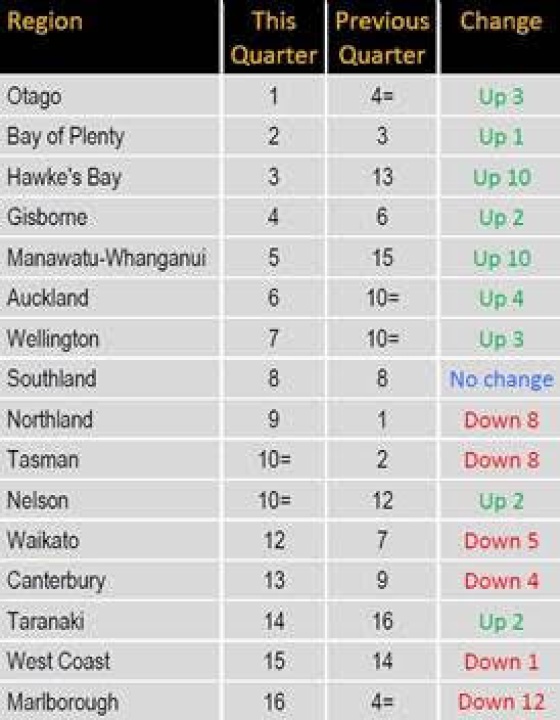ASB Regional Economic Scoreboard Q2 2018
Tuesday 18 September 2018
Otago climbs to top spot on the ASB Regional Economic Scoreboard
• Otago is top dog this quarter, climbing three places to take out the top spot
• Hawke’s Bay and Manawatu/Whanganui regions were big movers, both jumping 10 places
• Horticulture continues to shine through, boosting Bay of Plenty, Hawke’s Bay and Gisborne
Employment, tourism and housing growth sees Otago named best performing region for Q2
Strong growth across a number of sectors has seen Otago move into top spot for the second quarter of the year, securing a five star rating alongside just two other regions – Bay of Plenty and Hawke’s Bay.
In the year to June, employment jumped 10%, significantly ahead of the previous year and above the national average of 3.7%. The tourism sector also saw a boost, unlike most other tourism hotspots around the country.
ASB chief economist Nick Tuffley says he expects Otago to remain strong over the coming year.
“House price growth throughout the region remains impressive, with Dunedin City prices continuing to outshine their flashy lake cousin’s. Moreover, building consent issuance has rebounded, particularly for non-residential work,” Tuffley says.
“On top of the tourism boom, we anticipate that Otago rural incomes are also strong. Indeed, with both sectors firing, we anticipate that Otago will challenge for the medals over the next few quarters.”
Hawke’s Bay and Manawatu/Whanganui were the big movers, both climbing ten spots
Solid housing markets in the Hawke’s Bay and Manawatu/Whanganui regions have helped both climb ten places this quarter, with Manawatu/Whanganui posting the fastest house price growth across the country.
“The region will also be benefitting from the record high lamb prices, with Feilding saleyards no doubt doing a roaring trade,” Tuffley says. “With lamb prices likely to remain near record highs over the rest of the year, we expect the region to kick on probably over 2018, if not well into 2019.”
In the Hawke’s Bay, continued horticultural growth has also contributed to the jump.
“The region’s grape harvest this year was up a bumper 22% on last year,” Tuffley says. “With that in mind, we raise a glass to the region’s economic performance this quarter.”
Horticulture proves fruitful for the regions
The Hawke’s Bay, Gisborne and Bay of Plenty all benefitted from strong horticultural sectors, with the Kiwifruit export season in particular getting off to a good start in the Bay of Plenty.
The region’s labour market is also up 6.5% annually and is expected to continue setting record highs in returns this season according to Tuffley.
“It was unsurprising to see Bay consumers upbeat about their lot, with the consumer confidence reading sitting second-highest in the country. All up, we expect the Bay economy to remain on the front foot over the second half of 2018.”
Weaker construction sees Marlborough slide 12 places
Marlborough hit a speed bump this quarter, dropping to the bottom of the Scoreboard. The main drag on the region was a weaker construction sector which fell 23% compared with the rest of the country which had an average increase of 15%.
Nationally, total consent values were up nearly 16% on the previous year, with similarly-sized increases for both residential and non-residential work. Despite this, Tuffley says capacity constraints would likely make further growth difficult over the rest of 2018 and the following years.
Despite Marlborough’s fall, Tuffley was optimistic it would rebound.
“The weak construction in Marlborough could potentially be due to the lumpy nature of building consents. Meanwhile, this year’s grape harvest was solid, rising 4% on 2017’s,” Tuffley says.
“On this positive note, we expect the region to bounce off the bottom of the Scoreboard next quarter.”
Northland and Tasman see a fall in fortune
After a brief reign at the top of the leader board last quarter, Northland fell 8 places to tenth equal on the Scoreboard.
Retail, house and car sales all lagged behind the national average, and these falls explain much of the North’s drop down the rankings Tuffley says.
A weaker construction outlook in Tasman could also explain much of the region’s fall, Tuffley says.
“In smaller regions such as Tasman, construction projects can be particularly lumpy, so there is the possibility that the region isn’t down for long. Indeed, the retail sector remains strong, with Tasman’s retailers taking out the gold for sales growth over the quarter. And with horticulture strong, we wouldn’t be surprised to see Tasman bounce back later in the year.”

http://img.scoop.co.nz/media/pdfs/1809/ScoreboardQ22018.pdf
ends



 Insurance and Financial Services Ombudsman: Woman Gets $40k More After Disputing Insurer’s Decision
Insurance and Financial Services Ombudsman: Woman Gets $40k More After Disputing Insurer’s Decision BNZ: A Quarter Of Older NZers Fear Going Online Due To Scam Concerns
BNZ: A Quarter Of Older NZers Fear Going Online Due To Scam Concerns University of Auckland: Scientists Develop Tool To Monitor Coastal Erosion In Fine Detail
University of Auckland: Scientists Develop Tool To Monitor Coastal Erosion In Fine Detail Oji Fibre Solutions: OjiFS Proposes To Discontinue Paper Production At Kinleith Mill
Oji Fibre Solutions: OjiFS Proposes To Discontinue Paper Production At Kinleith Mill Hugh Grant: Navigating Digital Adoption In New Zealand - Embracing Change For A Bright Future
Hugh Grant: Navigating Digital Adoption In New Zealand - Embracing Change For A Bright Future Dawn Aerospace: Historic Flight - Breaks Sound Barrier And Global Records
Dawn Aerospace: Historic Flight - Breaks Sound Barrier And Global Records



